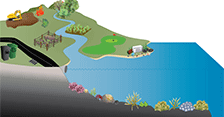How are land and sea connected? |
Pacific islanders know that everything we do on land will eventually affect the sea. Coral reefs are impacted by our actions on land that carry nutrients, sediments, trash, and pollution onto the reef. These impacts often magnify the threats from climate change and increase stress on corals.
Excess amounts of nutrients can cause algae to grow very quickly, which can smother and kill coral. Excess nutrients come from sewage from livestock and humans, and fertilizers that we use for agricultural practices, lawns, and golf courses.
 Sediment can wash onto a coral reef when large areas of land are bulldozed, such as for development or poor agricultural practices. The rain can wash the soil into streams, and eventually into the ocean, where it will bury the corals and kill the reef.
Sediment can wash onto a coral reef when large areas of land are bulldozed, such as for development or poor agricultural practices. The rain can wash the soil into streams, and eventually into the ocean, where it will bury the corals and kill the reef.The trash and debris that washes off the streets, such as oil from our cars, ends up in the storm drains that carry it to the ocean and onto the reef.
There are ways that we can limit the amount of pollution that we release onto the reefs! We can install advanced sewage treatment plants, limit our use of fertilizers, take precautions to catch any dirt and debris that washes off land before it enters the streams, and pick up our trash. If everyone works together, we can support healthy reefs.
| Pua ke kÅ(kahako o), ku ka he`e. When the sugar cane tassels, the octopus season is here. — Hawaiian proverb | Changes we observe on land are connected to changes we observe in the ocean and on coral reefs. To keep our reefs healthy we must be good stewards of the land and ocean. |






